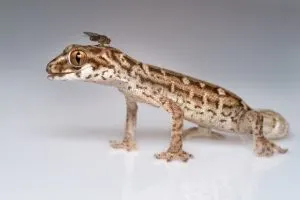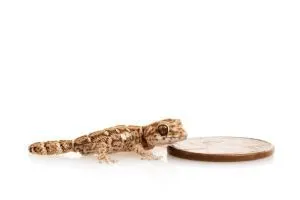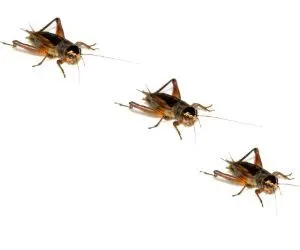Viper Gecko Care Sheet
Viper gecko care can be a rewarding experience for novice reptile keepers. These small desert-dwelling geckos are relatively easy to care for and can be great fun to observe.
They have beautiful, distinctive coloring and can also be housed in larger communal groups. Here’s our complete guide to caring for your Viper gecko(s).

Quick reference section
- Experience level: Beginner
- Scientific name: Teratolepis fasciata
- Family: Gekkonidae
- Alternate names: Carrot-tail gecko, Turnip-tail gecko
- Size and weight: Adult Viper geckos will rarely grow larger than 3 or 4 inches.
- Lifespan: Around 10 years in captivity
- Diet: As insectivores, Viper geckos will eat small insects such as crickets, locusts and mealworms
- Conservation status: Least concern
Interesting facts about Viper geckos
As communal reptiles, a group of Viper geckos can be happily housed together. However, an enclosure that contains two males will result in territorial clashes. Only have groups of females, or include just one male.
What does a Viper gecko look like?

Viper geckos are small, lively geckos, rarely exceeding 3 to 4 inches as adults. They have a beautiful unique pattern of banded scales. Long dark vertical bands run down their whole body, with smaller horizontal bands, often a lighter color, across their width.
Viper geckos are mainly brown or gray in color. They have bulbous tails which store fat and give them their alternative name of ‘carrot-tailed gecko’.
Where can Viper geckos be found?
Viper geckos are land-dwelling lizards and mainly live in dry desert areas of south eastern Pakistan.
What kind of habitat?
Hailing from the south eastern deserts of Pakistan, Viper geckos usually live in sandy, arid areas. They like to hide in rocky crevices or bask in the sun during the day, and hunt at night.
What does the Viper gecko eat?
Viper geckos are nocturnal insectivores, and will usually eat crickets and locusts and occasionally mealworms.
How do Viper geckos breed?
During breeding periods, females will usually lay a pair of eggs in sand every two to three weeks. The eggs usually hatch between two to three months after laying.
What predators do Viper geckos face?
Being so small, Viper geckos will see most larger animals as predators. They will drop their tails if they feel threatened. Birds and larger lizards and other reptiles are common predators of the Viper gecko.
Where can I buy?
Viper geckos can be purchased from recommended sites such as Josh’s Frogs.
Viper gecko Care sheet
Habitat
Setup Product List
- Enclosure: Reptizoo 8x8x12
- Lighting: UVB Lamp Fixture, UVB bulb, timer
- Heating: Heat Lamp Fixture, Heat lamp bulb, Thermostat, Hygrometer
- Humidity: Exo Terra Spray Bottle
- Substrate: Zoo Med Reptisand
- Hide: Exo Terra Gecko Cave
- Plants: Devils ivy
- Decor: Stones
Enclosure
For a single or pair of geckos, an 8x 8x 8 enclosure is a good size. For larger communal groups, a 12x 12x 12 setup should be the minimum size, or around 10 gallons. Wooden vivariums work best as they help retain heat, but glass is also an option.
Do not house males together, simalrly to leopard geckos being housed together they will fight. Younger geckos can climb smooth surfaces, so seal any gaps in the enclosure.
Sand is the ideal substrate for adult Viper geckos, and can also hold some warmth. A mix of sand, clay and soil works well, as Viper geckos like to dig.
Cleaning
Spot clean the enclosure daily, and do a full clean once or twice a month. Make sure to use a reptile-safe cleaner. Clean the substrate around once a week to remove feces.
Temperature
Coming from an arid, desert climate, Viper geckos need a temperature gradient to simulate their natural habitat. Their enclosure must have warm and cool sections.
The gradient should be around 75-85 degrees Fahrenheit, while at night the temperature can safely dip to about 70 F. Use a heat lamp to provide a basking spot at around 95 F.
Check the basking spot temperature with a temperature gun, and use a thermometer for the rest of the enclosure.
Humidity
Ambient humidity should be around 40-50%, but you will need to provide a humid hide for shedding and breeding. Damp moss or peat moss works well as a base for this. The humidity in this hide should be around 50-60%.
Mist the enclosure 2-3 times a week at night. Ventilate the enclosure enough that it becomes dry a few hours after misting. Use a hygrometer to measure the humidity.
You can provide a water dish but it isn’t strictly necessary, should be changed every day.
Lighting
As they like to bask, Viper geckos need UV to meet their bodily needs. 2-10% UVB is ideal, as this helps them get enough vitamin D and calcium.
A standard fluorescent bulb on a 10-12 hour timer to simulate a day-night cycle should be sufficient.
Accessories
Provide lots of rocks and crevices for your Viper geckos. They like to nestle into crevices during the day, but also require a basking spot such as a flat rock.
Viper geckos will require several shelters; one in the warm section, one in the cold section, and a humid hide (see above).
Providing some logs and bits of bark can give your geckos plenty of other hiding spots. Live or artificial plants are also good additions. Make sure that any accessories you add cannot fall and harm your geckos, especially if they start digging.
Feeding

Viper geckos are insectivores, and as such their diet should mainly consist of live food. Crickets and locusts should be staples, while meal and wax worms can be occasional treats. Live food should also be gut loaded before feeding, and should be small enough to fit between the geckos eyes.
Feed adults two to three times a week. Around three meals a week should be dusted with a calcium supplement, while one meal per week should be dusted with multivitamins. Calcium is especially important for females during breeding.
Temperament and handling
Handling should be kept to a minimum, as these small geckos will drop their tails if they feel threatened. A communal group of a male and several females can live together quite happily.
These geckos are active around nighttime and can be fun to watch, but you may also see them basking on rocks during the day.
Signs of good health
If your gecko has a plump, fat tail and is quite active and curious, they should be in good health.
Health concerns
If their UV and supplement needs aren’t met sufficiently, Viper geckos may be at risk from Metabolic Bone Disease (MBD).
This can be caused by an imbalance in your gecko’s calcium and vitamin D levels. It can particularly affect insectivores like Viper geckos.
Symptoms of metabolic bone disease can include; limping, decreased appetite, struggling to raise the body off the ground, hard lumps affecting the legs, spine, or jaw.
Conclusion
Viper geckos can be rewarding and exciting lizards to keep. They are fun to observe hunting live food or basking on rocks, but are more active at night.
They are great for novice keepers as their needs are simpler in terms of heating and lighting when compared to species like bearded dragons.
Viper geckos can also be housed in communal groups, providing a varied cast of characters! However, males cannot be housed together.
Viper geckos are also not the best choices if you want to handle your geckos, as their tails will drop if they feel threatened. For handling, better alternatives include Leopard Geckos or Crested Geckos.
Table of Contents


